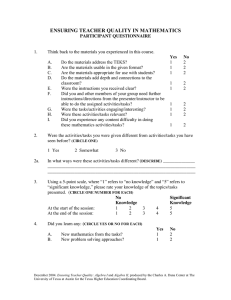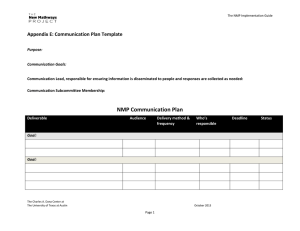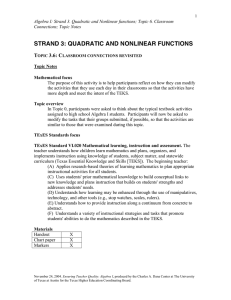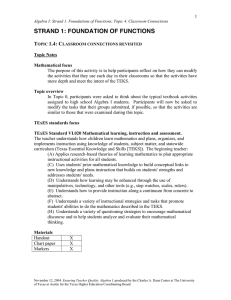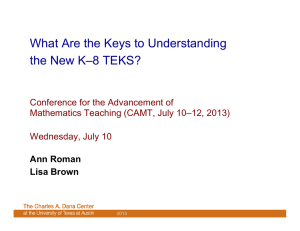Algebra I Assessments Sampler sample performance tasks taken
advertisement
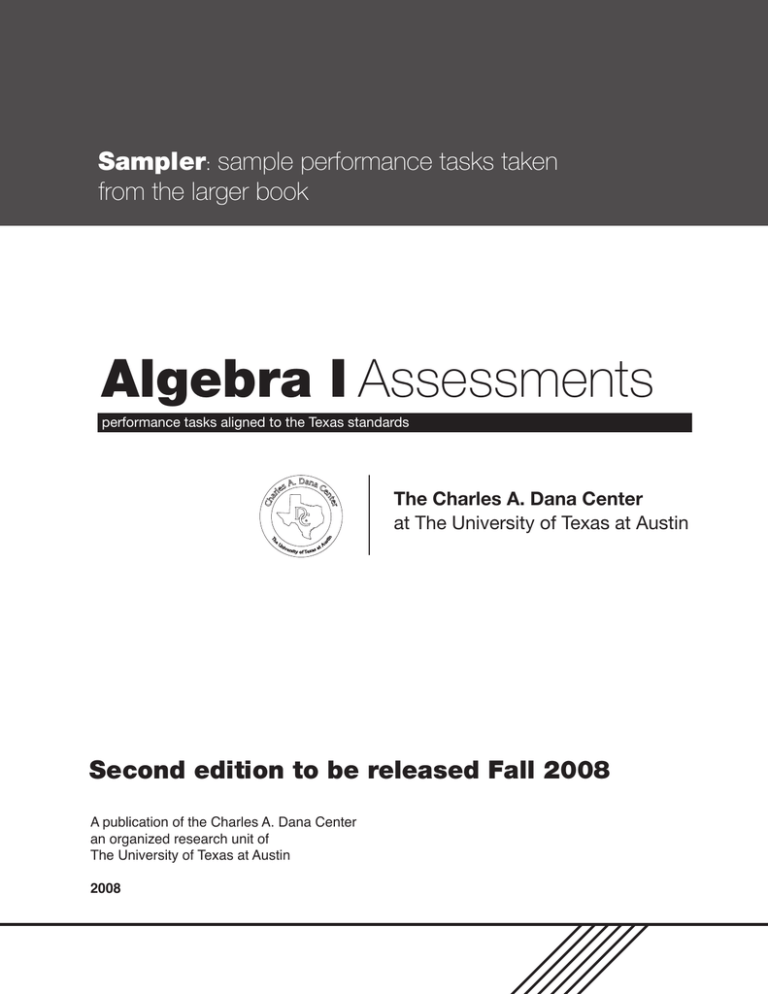
Sampler: sample performance tasks taken from the larger book Algebra I Assessments performance tasks aligned to the Texas standards The Charles A. Dana Center at The University of Texas at Austin Second edition to be released Fall 2008 A publication of the Charles A. Dana Center an organized research unit of The University of Texas at Austin 2008 About the Charles A. Dana Center at the University of Texas at Austin The Charles A. Dana Center (www.utdanacenter.org) supports educators, education leaders, policymakers, and communities in strengthening education. As a research unit of The University of Texas at Austin’s College of Natural Sciences, the Dana Center maintains a special emphasis on mathematics and science education. The Dana Center’s mission is to strengthen the mathematics and science preparation and achievement of all students. We do this through supporting alignment of all key mathematics and science education components, prekindergarten–16: mathematics and science standards, accountability systems, assessments, and teacher preparation. For more information about the Dana Center and its programs, see our homepage at www.utdanacenter.org. For additional resources to strengthen your mathematics program, see our Mathematics TEKS Toolkit at www.mathtekstoolkit.org and our web catalog at www.utdanacenter.org/catalog. For information and online signup for our additional professional development offerings for leaders and teachers, mathematics educators, and science educators, see our professional development site at www.utdanacenter.org/pd. The University of Texas at Austin The Charles A. Dana Center 2901 North IH-35, Suite 2.200 Austin, Texas 78722-2348 www.utdanacenter.org i Copyright and terms of service First edition copyright Charles A. Dana Center, The University of Texas at Austin, 2002. The second edition is copyright Charles A. Dana Center, The University of Texas at Austin, 2008. Unless otherwise indicated, the materials found in this publication are the copyrighted property of the Charles A. Dana Center at The University of Texas at Austin (the University). No part of this publication shall be reproduced, stored in a retrieval system, or transmitted by any means—electronically, mechanically, or via photocopying, recording, or otherwise, including via methods yet to be invented—without express written permission from the University, except under the following conditions: 1) We cannot grant you permission to use materials that we do not own. Any requests for permission to use materials which include a copyright notice other than our own should be directed to the owner of the copyright rather than to the University. The following specifically excludes materials not owned by the Charles A. Dana Center at the University of Texas at Austin. a) Teachers and educational administrators may reproduce and use one printed copy of the material for their personal use without obtaining further permission from the University, subject to the terms and conditions listed below (item 2). b) Teachers may reproduce multiple copies of pages for student use in the classroom, subject to the terms and conditions listed below (item 2); c) Organizations or individuals other than those listed above (items a and b) must obtain prior written permission from the University for the use of these materials, the terms of which may be set forth in a copyright license agreement, and which may include the payment of a licensing fee, or royalties, or both. 2) Terms and conditions Any portion reproduced must remain unedited from the original. The following copyright and attribution notice must be affixed to each copy produced: Copyright 2008, Charles A. Dana Center at The University of Texas at Austin ii In keeping with our longstanding practice, we use all funds generated through use of our materials to further our nonprofit educational mission. Please send your permission requests or questions to this address: Charles A. Dana Center P.O. Box M Austin, TX 78713 Fax (512) 232-1855 dcshop@lists.cc.utexas.edu We have made extensive efforts to ensure the accuracy of the information in this resource. The Charles A. Dana Center and The University of Texas at Austin, as well as the authors and editors, assume no liability for any loss or damage resulting from the use of this resource. If you find an error, please email us at dcshop@lists.cc.utexas.edu. We have made every effort to provide proper acknowledgment of original sources and to comply with copyright law. If cases are identified where this has not been done, please contact the Charles A. Dana Center at dcshop@lists.cc.utexas.edu to correct any omissions. iii What is Algebra I Assessments? Teachers can use these Algebra I performance tasks to provide ongoing assessment integrated with Algebra I instruction. The assessments, which reflect what all students need to know and be able to do in a high school Algebra I course, may be formative, summative, or ongoing. The assessments focus on students’ understanding of concepts and their procedural knowledge, instead of on “right” or “wrong” answers. The purpose of the assessments is to •clarify for teachers, students, and parents what is being taught and learned in Algebra I, •help teachers gain evidence of student insight and misconceptions to serve as a basis for instructional decisions, and •provide problem-solving strategies to guide instruction and enhance student learning. What’s new? Updated performance tasks Each of the performance tasks has been updated to reflect our new knowledge about assessing student learning. 2005 revised secondary mathematics TEKS We have updated Algebra I Assessments to include the revised secondary mathematics TEKS and to adjust performance tasks to meet the revised TEKS where necessary. How are the assessments structured? Each assessment includes a performance task as well as “scaffolding” questions that the teacher may use to help the student analyze the problem. The assessments also include sample solutions and questions for the teacher to use to extend the discussion. Teachers may use these performance tasks as formative or summative assessments for individual students or groups of students. Algebra I Assessments presents performance tasks and lessons from five categories that are based on key strands in the Algebra I TEKS: iv 1. Function Fundamentals 2. Linear Functions 3. Related Linear Functions and Systems of Equations 4. Quadratic Functions 5. Inverse Variation, Exponential, and Other Functions Where can I get a copy of Algebra I Assessments, second edition? Look for Algebra I Assessments in Fall 2008 by visiting our online catalog at www.utdanacenter.org/catalog. v TEKS and TAKS Resources The mathematics Texas Essential Knowledge and Skills (TEKS) were developed by the state of Texas to clarify what all students should know and be able to do in mathematics in kindergarten through grade 12. Districts are required to provide instruction that is aligned with the mathematics TEKS, which were originally adopted by the State Board of Education in 1997 and implemented statewide in 1998. Revisions to the Mathematics TEKS were adopted in 2005–2006 and implemented starting in Fall 2006. The mathematics TEKS also form the objectives and student expectations for the mathematics portion of the Texas Assessment of Knowledge and Skills (TAKS). The mathematics TEKS can be downloaded free of charge from the Dana Center’s Mathematics TEKS Toolkit website (www.mathtekstoolkit.org) or the Texas Education Agency website (www.tea.state.tx.us/teks). Perfect-bound and spiral-bound versions of the mathematics and science TEKS booklets are available for a fee (to cover the costs of production) from the Charles A. Dana Center at The University of Texas at Austin (www.utdanacenter.org/catalog). Resources for implementing the mathematics TEKS are available through the Charles A. Dana Center, regional education service centers, and the Texas Education Agency. Online resources can be found at in the Dana Center’s Mathematics TEKS Toolkit at www.mathtekstoolkit.org. The following products and services are also available from the Dana Center at www.utdanacenter.org/catalog: • Mathematics Standards in the Classroom: Standards-Aligned Performance Tasks for Kindergarten–Grade 2 (first edition, 2008) • Mathematics Standards in the Classroom: Standards-Aligned Performance Tasks for Grades 3–5 (second edition, 2008) • Mathematics Standards in the Classroom: Standards-Aligned Performance Tasks for Grades 6–8 (second edition, 2008) • Middle School Mathematics Assessments: Proportional Reasoning (2004) • Algebra II Assessments (second edition, 2007) • Geometry Assessments (second edition, 2007) • Poster-sized Mathematics TEKS charts • Professional development mathematics institutes for elementary, middle school, and high school teachers vi
